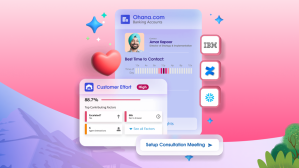Twelve years ago, Adam Blitzer launched Pardot, a B2B marketing automation company in Atlanta, Georgia. He grew the startup with no outside funding, and it became part of Salesforce in 2013. Blitzer has been a leader at Salesforce ever since, including overseeing Sales Cloud and Service Cloud. Last month, he started a new chapter as CEO of Marketing Cloud.
In this interview, we asked Adam about his proudest accomplishments to date, his plans for helping marketers succeed in his new role and what to expect at Dreamforce next month.
Can you share a bit about the background you bring to your new role?
I started Pardot with a friend from college. It was 2007, and soon the bottom fell out of the economy. We didn’t raise any funding, and instead built the company organically by focusing on the one thing we could control: how well we treated our employees and customers. After a few years, we wound up hitting a nice growth curve as the industry came into its own and won “Best Place to Work in Atlanta” two years in a row. In 2012, we sold the business to an email marketing leader called ExactTarget, and less than a year later ExactTarget was sold to Salesforce, which is when Marketing Cloud was officially created. We got Pardot to a good scale within Salesforce. Soon after that, I began to run our Sales Cloud business, which I did for about three and a half years. I also managed Service Cloud for a little while. All of this is to say that I’ve spent more than six years at Salesforce, so I know the range of products well. With my new role as CEO of Marketing Cloud, I’m excited to come back to my roots in martech.
What are your proudest accomplishments from your past six-plus years with Salesforce?
There’s a lot to be proud of. One is taking several months off when my daughter was born two years ago. I was able to spend a lot of time with her and get even closer to my son, who is now five. I was able to take advantage of getting the business to a great spot, having awesome leaders in place and giving them a lot of autonomy in order to do what was best for me and my family personally. I’m proud to work for a company with a great culture and benefits like Salesforce, and found it important to lead by example so that the team can create a work-life balance of their own when they need to.
I’m also proud that we successfully transitioned our sales portfolio from a single product to a multi-product portfolio. Sales Cloud is market leader in helping salespeople sell smarter and faster by centralizing customer information. Over the years, we’ve expanded Sales Cloud to offer customers multiple products including CPQ, which is a product for quoting deals and High Velocity Sales, which is a purpose-built inside sales product. We’ve also introducing artificial intelligence with Einstein across all Sales Cloud products.
I’m really proud of getting the product I started with, Pardot, to escape velocity. At ExactTarget, my goal was to get Pardot to be one of the top players at the company. At Salesforce, my goal was to win the market. It was a small business when we joined Salesforce, but it quickly became a clear leader in the space, and we continue to lead in B2B marketing.
What do you hope to accomplish in your first year as CEO of Marketing Cloud?
I’m focused on three key areas. The first is launching our customer data platform (CDP), which we announced at Connections this summer. This is a way for marketers to bring together data about their customers and prospects from all sources: demographics, engagement data, online behavior, past purchases, etc. And they can do rich, just-in-time segmentation to feed email campaigns, real-time personalization of websites and more. This product will address questions about data strategy that are top of mind for most CMOs.
Second, I’m really looking forward to taking the best of B2B marketing and B2C marketing solutions, that for a long time have been operating separately and targeting different buyer, decoupling them from the way they’re used today and turning them into services any marketer can use to better understand their customers and drive engagement.
My third goal is around real-time personalization and interaction management. This involves presenting a unique experience for each potential customer based on what the system knows about them, ultimately improving a company’s chance at turning them into a buyer. We launched a product called Interaction Studio last year, and I’m excited to expand in this quickly emerging space.
What challenges are marketers facing today, and how can artificial intelligence help?
I’ve been in marketing for more than 15 years, and the problems are exactly the same. Marketers are trying to do three things: segment the audience they want to engage with, orchestrate experiences across a growing number of marketing channels and do attribution to figure out what’s actually resonating with customers. But the channels have changed and the technology has changed, making these things easier in some ways and harder in others. I see AI as a big opportunity for marketers to drive improvements in all three areas:
Until recently, audience segmentation was a manual, offline process. Marketers would pick interesting customer segments and the campaigns they thought those groups would respond to, typically based on historical data. That’s a heavy cognitive load! Now, the idea of just-in-time segmentation is possible. AI can instantly and automatically suggest the right type of offer for a given segment or vice versa, without the marketer having to spend time slicing and dicing the data.
With orchestration, marketers can now have a single platform across all channels instead of multiple point solutions. If the system has enough historical data, it should suggest the type of content and channel to use at each step. AI becomes a copilot for the marketer.
With attribution, we now have the technology to get all marketing data in one place and be able to visualize and analyze it in order to know what marketing strategies, campaigns and investments are working. Attribution has always been much harder in the B2B world than in B2C, because the sales cycle is longer, and there are many different sales and marketing touchpoints engaging prospects and accounts. Today, marketers do attribution by either dividing up the value evenly by every touch the customer had, or by weighing it, but it’s pretty arbitrary.
With AI, the system can analyze complex interactions across hundreds of different touchpoints and figure out what dollar amount to credit to each. In the B2C world, AI can show you not only the results from the campaigns you’re running, but also provide hidden insights and recommendations for what to do. For example, a marketer can now easily know what the email engagement rate is looking like for a campaign, and be automatically notified to make changes with suggestions on what to do in order to improve customer engagement. AI works to make attribution much more actionable.
What are you most excited for at Dreamforce?
I’m excited about bringing out the best of B2B and B2C marketing on one stage during the Marketing Cloud keynote on Thursday, November 21st at 2:30pm PT. Today, the biggest companies in the world are trying to get closer to their customers, and when they don’t, they’re being disrupted by customer-focused brands. For example, Gillette used to own the razor market and sold through distributors. Now, you have Harry’s and other razor brands selling directly to consumers. Gillette lost around 20% of its market share over the last eight years, and the brand is more than 100 years old. You see the same thing happening across many industries. A lot of traditional B2B companies are trying to become more B2C in the way they operate. There’s a digital transformation happening, and we want to help companies as they reimagine their customer engagement strategies.
What’s something your colleagues might not know about you?
I’m a black belt in judo and lived in Japan for four years training at very high levels. What I loved about judo is that it’s a physical sport like wrestling—the goal is to throw someone. But it’s also a mental sport, like chess. You’re trying to stay one step ahead of your opponent and throw him off balance.
Did you learn any lessons from judo that serve you in the marketing world?
Definitely. In judo, there are three levels of opponents. The first tries to execute a game plan no matter what, and they’re easy to beat because they’re inflexible. The second counters based on what you do, and they’re tougher to beat. But the toughest opponents feel like they aren’t reacting to you. Instead, they are predicting what you’re going to do before you do it and are at the right place at the right time.
In marketing, you have those same levels of maturity. Most companies are closer to the first level–executing, no matter what their customers are doing. Better companies are responding to their customers–becoming more interactive, adapting channels based on what customers want and connecting marketing and sales. They’re moving from a system of execution to engagement. Where marketing is trying to get to is not just reacting to customers, but predicting what they’re going to need and showing them the right content at the right time. That’s where marketing becomes a system of intelligence.



















